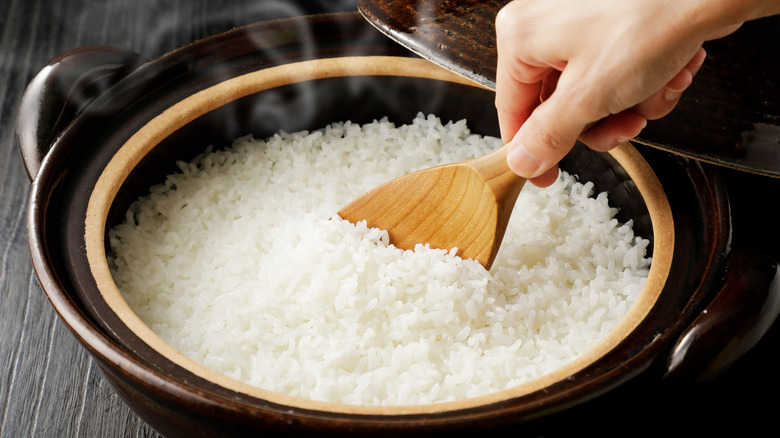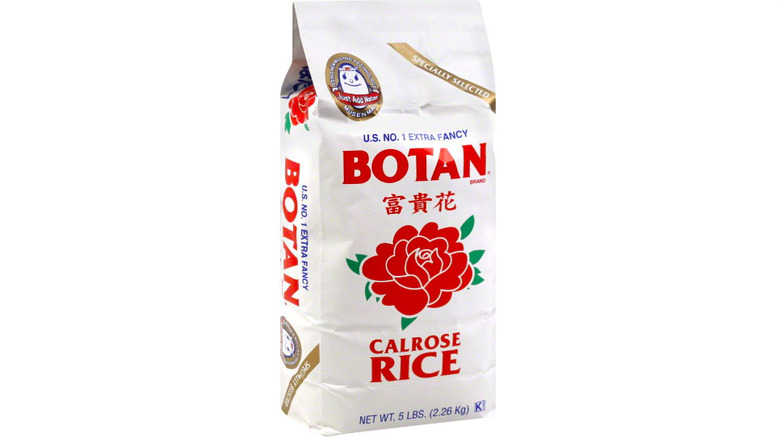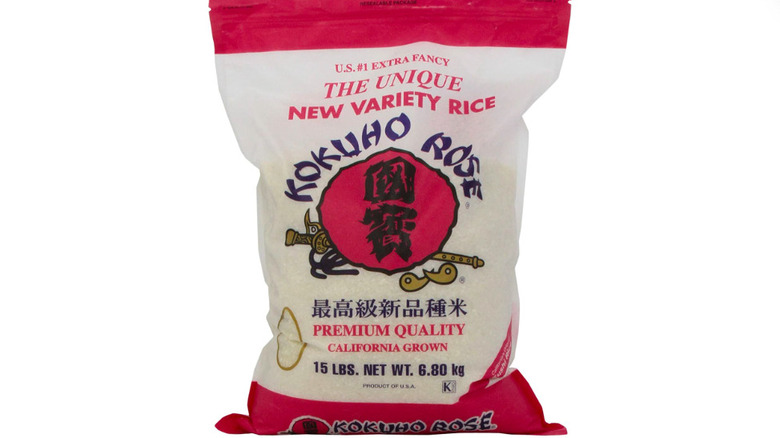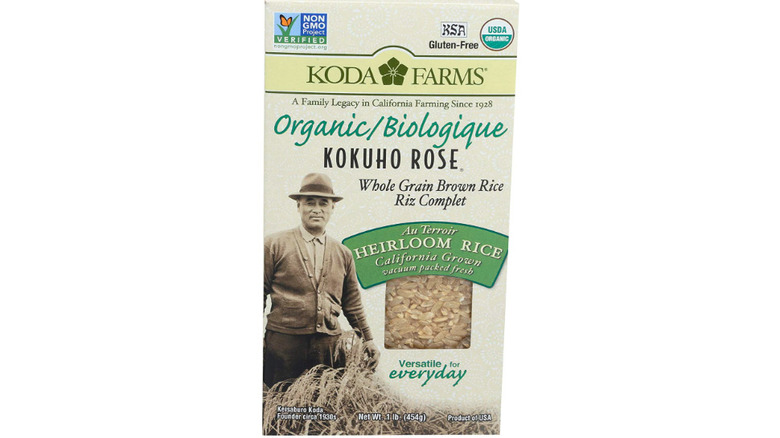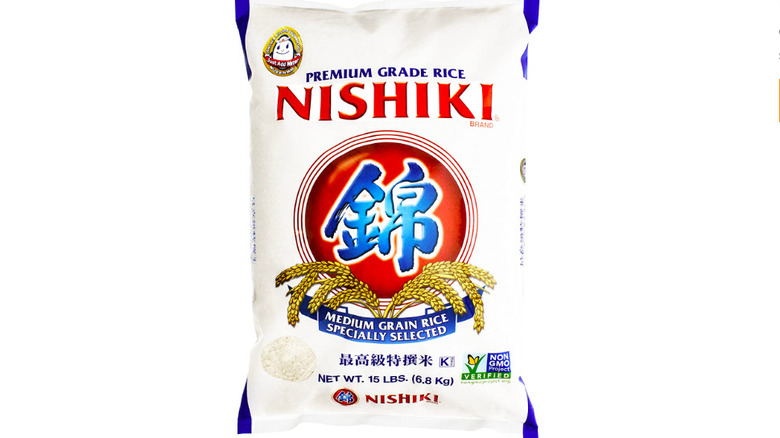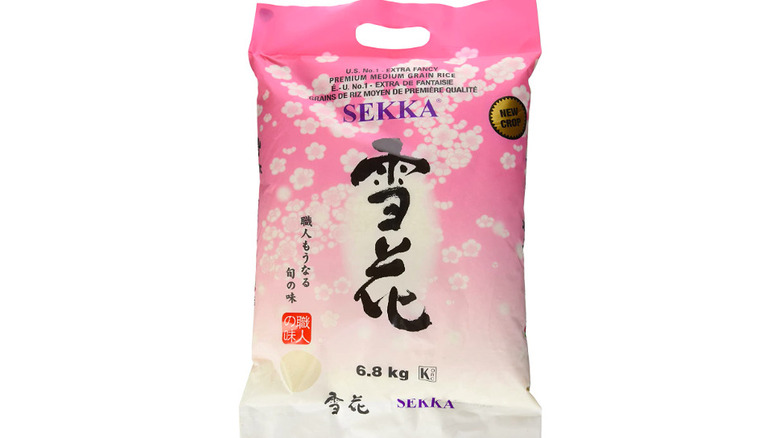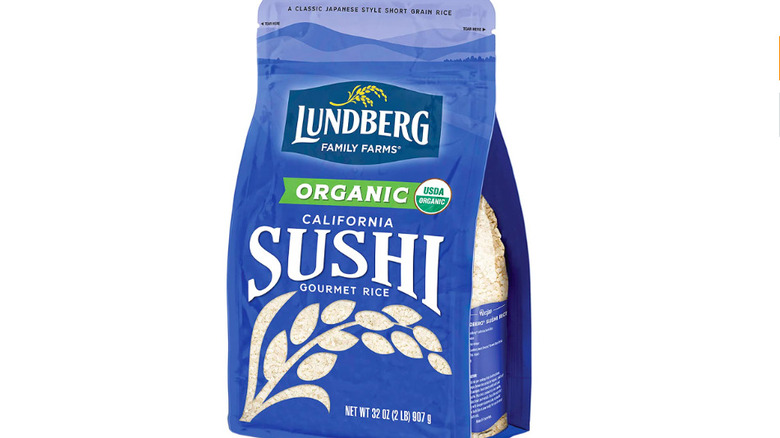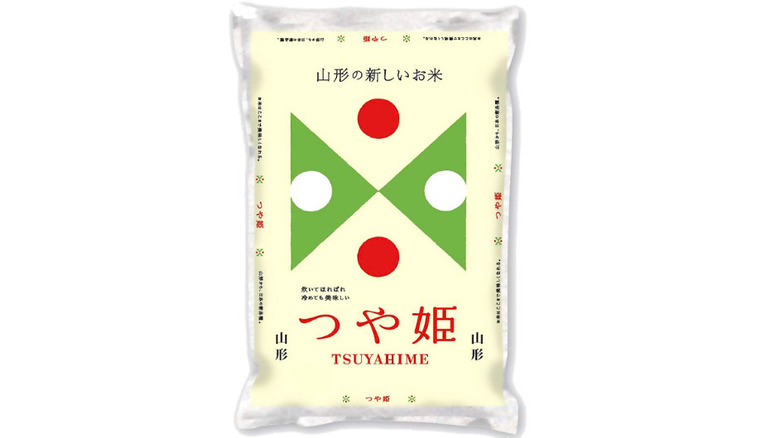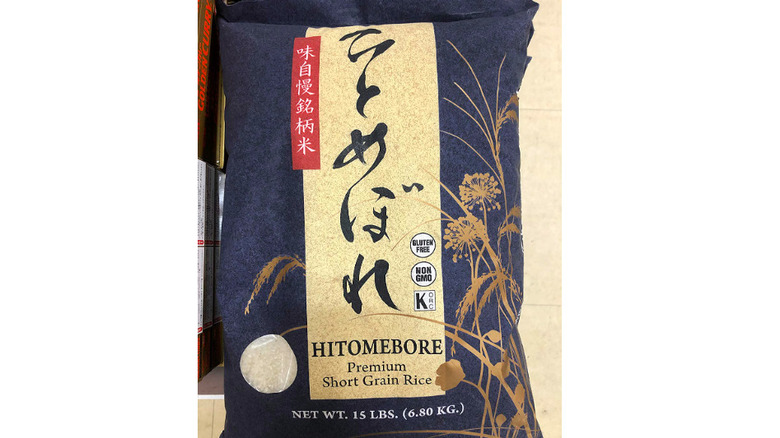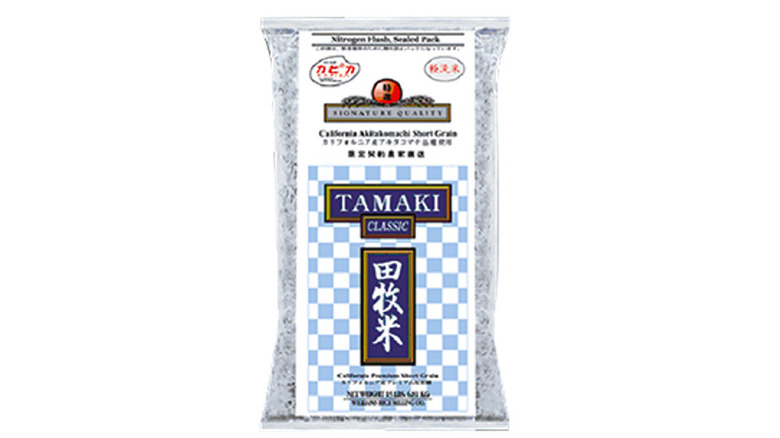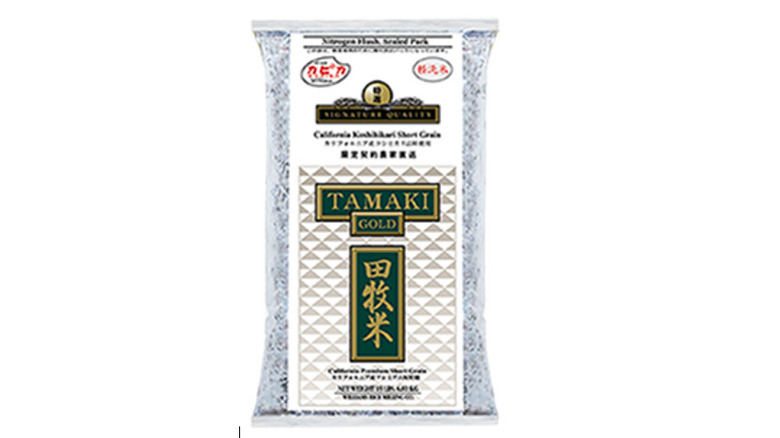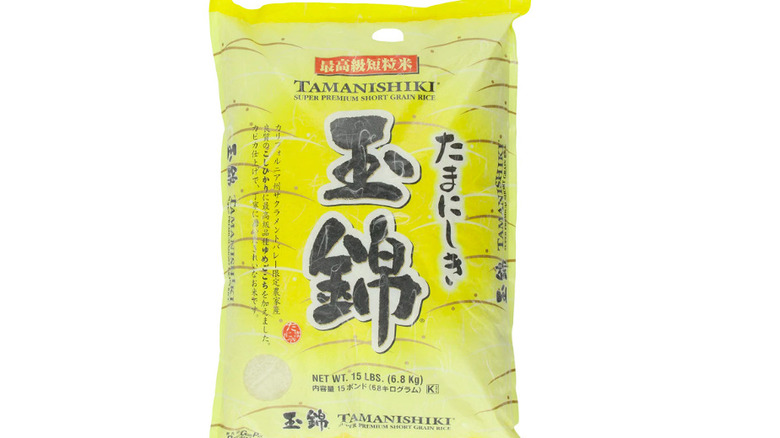11 Best Sushi Rice Brands Ranked
Sushi, now an internationally beloved dish, originated centuries ago in the mountains of Southeast Asia as a way to preserve fish. JW magazine explains that this method, called narezushi, involves fermenting the fish in a mixture of rice and salt. This method was discovered during the Nara period (A.D. 710-794) and was used to preserve fish throughout the year when it was not readily available. In those days, the rice was usually thrown out and just the fish was eaten, and it was not until the Muromachi period (A.D. 1333-1573) that eating rice became a common practice among everyday people. By the end of the Edo period (A.D. 1603-1867), the most common types of sushi we see today, nigiri, inari, and maki, had been developed and were commonly eaten as street food in Edo, known as Tokyo today.
So what exactly is sushi and what makes it so unique? According to Chef Nami from Just One Cookbook, sushi refers to "rice seasoned with sweetened vinegar" and is not to be confused with sashimi. The difference between sushi and sashimi is that sashimi is a high-quality food, most commonly seafood, that has been cut with precision. Sushi, on the other hand, regardless of its filling, topping, or shape, always incorporates rice. This makes sushi rice, called sumeshi in Japan, undoubtedly the most important component of sushi.
11. Botan Calrose
Sushi is traditionally made with short-grain rice, and as per Just One Cookbook, short-grain rice is only a little bit longer than it is wide and has a higher starch content than other types of rice, allowing it to clump together without becoming mushy. Compared to short-grain rice, medium-grain rice is not as glutinous, preventing it from clumping in the way traditional sushi rice does. Nonetheless, medium-grain rice varieties are often used for sushi in restaurants and by home cooks because of their wider availability, affordability, and similar flavor.
Calrose rice is a medium-grain rice variety that was developed in California after WWII. Calrose rice now makes up the majority of rice grown in California and is widely consumed in restaurants and households in the US and around the world. As per The Japanese Way, a key trait of good sushi is its stickiness, and thanks to Calrose's high levels of amylopectin, it is able to reach a similar level of stickiness to traditional sushi rice, making it a fantastic medium-grain alternative.
Each grain of Botan Calrose rice is specially selected to provide consumers with the highest quality, and it is easily cooked on the stovetop or in your rice cooker. According to Rice&, experts in Japanese rice, Botan Calrose is a premium medium-grain rice option that has a delicate flavor that lends itself to many preparation styles, making it incredibly versatile. To make sushi rice, you must first rinse the rice. This process is important because it removes as much starch as possible from the grains and helps ensure that your sushi rice will not be gummy. Botan Calrose rice is available "musenmai," meaning that the kernels are pre-rinsed so that they do not require washing prior to cooking, saving you time and water.
10. Kokuho-rose, Nomura Co.
Like the other medium-grain rice varieties, Kokuho-Rose rice from Nomura Co. does not have the traditional characteristics of sushi rice, preventing it from making truly authentic sushi. Nonetheless, how Kokuho-Rose rice is grown and produced provides consumers with a high-quality, delicious product. Kokuho-Rose rice from Nomura Co. can be purchased online or at most grocery stores, especially those carrying Japanese ingredients. It is also the preferred rice of chef and educator Sonoko Sakai, who uses Kokuho-Rose rice in many of her dishes. Kokuho-Rose, different from Heirloom Kokuho-Rose, is affordable and versatile, meaning that it can be used for sushi or eaten with many other dishes like stir frys and curry.
Original Kokuho-Rose rice was developed by Koda Farms in California after WWII by plant breeders using rice strands from all over the world. Variations of the original Kokuho-Rose are now grown across California and are known for their affordability and versatility. Kokuho-Rose is a mix of rice varieties, one of which includes Calrose, which is where Kokuho-Rose derives part of its name. Therefore, Kokuho-Rose and Calrose are genetically similar, but when it comes to taste, Kokuho-Rose maintains a fuller flavor with the same stickiness and bite as Calrose. Compared to its premium sister, Heirloom Kokuho-Rose rice, Kokuho-Rose by Nomura Co. is more affordable and easily accessible.
9. Koda Farms Heirloom Kokuho-Rose
Owned and operated by a Japanese-American family for generations, Koda Farms produces high-quality medium-grain rice, like their famous Heirloom Kokuho-Rose, that can be used for sushi and other rice dishes. Not to be confused with general Kokuho-Rose rice, which is now grown across California, Heirloom Kokuho-Rose is the original Kokuho-Rose variety developed and grown by the Koda family. Oiishi-Desu explains this confusion. Once Kokuho-Rose rice gained popularity across the US, permission was granted to other farms and manufacturers to take the Kokuho-Rose KR55 strand to produce their own hybridized versions of Kokuho-Rose. To this day, Koda Farms is the sole producer of the pure KR55 strand, but now other businesses, like Nomura Co., have similar varieties, making Kokuho-Rose rice widely available yet confusing in name!
Koda Farms Heirloom Kokuho-Rose remains the superior Kokuho-Rose rice variety. Koda Farms describes its famous KR55 strand as a thoroughbred racehorse, claiming that all premium rice varieties grown in California share some genetic similarities to the KR55 strand but not its supreme sheen and flavor. Because of its lineage and the meticulous cultivation practices undertaken by Koda Farms to ensure that the highest quality rice is grown, Heirloom Kokuho-Rose rice is premium rice, selling at a considerably higher price compared to normal Kokuho-Rose.
Nonetheless, it is worth the extra money. Heirloom Kokuho-Rose rice is beloved for a reason and remains prized for its flavor, sheen, and stickiness even after it has cooled. Koda Farms suggests using a rice cooker for cooking your Heirloom Kokuho-Rose rice because the steam of a rice cooker helps the floral notes of the rice blossom. If you do not have a rice cooker, Heirloom Kokuho-Rose rice can also be cooked successfully on the stove.
8. Nishiki
Nishiki rice is internationally beloved and makes for a great everyday rice option, sushi, and other dishes. It is another medium-grain rice developed and grown in the California central valley. Although it is not a short-grain variety, it consistently produces high-quality sushi rice, delivering on flavor, sheen, and bite. The manufacturer of Nishiki rice, JFC International Inc, claims that sushi experts prefer Nishiki rice for its superior flavor and texture, so this may explain why it is a number one seller at both Amazon and Walmart! Nishiki rice is also highly valued for its reliable consistency and versatility.
When buying sushi rice, something to take into consideration is the age of your rice. It is incredibly important that, when possible, you purchase shinmai (新米) rice because this indicates that the rice is from the most recent crop and, therefore, the freshest. According to the All About Sushi Guide, the ideal age for sushi rice is 6 months to 1-year-old. Rice older than this can still make delicious sushi but will be dryer and therefore require more water when cooking. Nishiki regularly offers shinmai rice at a reasonable, if not the same price.
Nishiki also comes in other variations, such as genmai, which is a type of fast-cooking brown rice that has been milled in a way that shortens its cooking time. This allows you to have brown rice in only a fraction of the time it usually takes to cook brown rice. Another point for Nishiki is its low price, making it a great option for those looking for a rice brand that is delicious, versatile, and affordable.
7. Sekka
Sekka is another medium-grain rice option that serves as a great alternative to short-grain rice. Sekka rice is described as an extra fancy medium-grain rice option that will be good enough for even the pickiest chefs. Compared to the other medium-grain rice varieties on this list, Sekka is of higher quality, measured in its depth of flavor and each individual kernel's bright sheen.
Most of the other medium-grain rice varieties on this list stem from the Calrose variety, which Sekka does not. This means that it has a unique flavor compared to the Calrose hybrids, which all share some degree of similarity.
The premium grade of Sekka rice is reflected in its higher price point. Sekka rice is slightly more expensive than other medium-grain rice options, but if you are looking for a rice variety that preserves well after cooking and has a quality that you can taste, it is worth the higher price. Considering that it is more of a specialty item, Sekka rice is not as widely available as some other rice varieties. You can buy it online but may need help finding it in stores.
6. Lundberg Family Farm Sushi Rice
Lundberg Family Farms offer many varieties of rice and quinoa available at their local farm store in California or for sale online. They grow over 20 different varieties of grain, one of which is their prized short-grain sushi rice. This variety, grown in California, is described as "clean and crisp," with a hearty bite from each individual kernel.
They offer products that are both organically and conventionally grown, which accommodates different price ranges and consumers who are looking for specific products. All the rice and quinoa cultivated at Lundberg Family Farm are grown using sustainable agricultural procedures, making their products more environmentally friendly and delicious. The specific measures they take to limit their carbon footprint, keep their soil healthy, and partner with nature can be seen in their diligent dedication to cover cropping and providing habitat for migratory birds.
You can find a collection of delicious recipes on their website, including their signature Onigirazu Sushi Sandwich, which is made of sushi rice, nori, vegetables, and sauce. If you are making sushi rice, it is important that you gently fold your sushi seasoning, which you can buy premixed, or make yourself with rice vinegar, salt, and sugar into the rice when it is still warm. The seasoning must be mixed in when the rice is still warm to ensure it's distributed evenly. This helps develop sushi's signature sheen and flavor.
5. Tsuyahime
Developed in the Yamagata prefecture of Japan, which is known for its temples, hot springs, and mountains, Tsuyahime rice is a brand of short-grain rice that is gaining in popularity across Japan, and the world, for its floral flavor and shiny grains. Described as supremely pure with "pleasing uniformity," Tsuyahime rice is exceptional in flavor, color, and texture. This rice variety is still incredibly young, meaning that it is being cultivated mostly on a small scale, primarily in Yamagata. This ensures that each plant and grain are cared for by experienced farmers to produce remarkably high-quality rice.
The origins of Tsuyahime rice stem back to the famous rice strand Kameno-o, which was grown by the legendary Kameji Abe to produce rice for eating and sake. Kameno-o rice is also a parent variety of the now internationally beloved rice variety Koshihikari, but Tsuyahime, with its unique combination of favorable characteristics, aims to surpass Koshihikari production and sales soon.
A downside to Tsuyahime rice is that it is not well distributed across the US. It may be available in some specialty stores but most likely would need to be purchased online at a fairly high price. Nonetheless, if you do acquire Tsuyahime rice, it will make supreme sushi rice where each kernel is cooked evenly and to perfection.
4. Hitomebore
Hitomebore means "falling in love at first sight," and the farmers of the Miyagi province, where Hitomebore rice originates, named their rice Hitomebore because they said that anyone who eats this rice would fall in love at first bite. This short-grain rice is a blend of the beloved Koshihikari variety and other varieties, producing a superior rice variety that balances softness and stickiness while remaining deliciously light and moist, even when cold.
Hitomebore makes delicious sushi rice prized for its fluffiness, natural sweetness, and stickiness, giving your sushi depth of flavor and a satisfying chew. Once you mix your sushi rice seasoning into your cooked Hitomebore, you can add other ingredients like sesame seeds for texture. Even when cold, Hitomebore rice is delicious, making it a great sushi rice option, but also good for bento, onigiri, or any rice lunch on the go.
According to Oishii Desu, Hitomebore is the second most popular rice in Japan and is quickly gaining popularity in the US. The combined flavor, texture, and gentle sweetness this rice offers will make you fall in love at the first bite, just like the farmers in Miyagi claim.
3. Tamaki Classic
Tamaki Classic sushi rice is grown following strict agricultural procedures to ensure that the highest quality of sushi rice is produced. It is then milled with traditional Japanese milling equipment, which polishes each grain to perfection. Thanks to its impressive flavor, this rice will surely satisfy any of your rice cravings and will make stellar sushi rice that is fluffy, sticky, and shiny. While it is the lower-tier choice of the Tamaki options, it is the more affordable of the two and still delivers on quality and flavor. However, even Tamaki Classic rice is fairly expensive compared to the other brands listed, but it will not disappoint you with its astounding flavor.
When buying sushi rice, one variety is prized for its consistency, flavor, and sheen: Koshihikari. According to All About Sushi Gude, Koshihikari rice was developed in the Fugui prefecture in the 1950s and, since then, has quickly gained in popularity. Nippon Magazine states that Koshihikari rice is consistently ranked as one of Japan's most preferred rice varieties. Most sushi rice brands are either pure Koshihikari or share some genetic similarities with this famous variety. Niki Nakayama, the owner of n/naka, a two-Michelin-star restaurant in Los Angeles, uses Koshihikari rice to make onigiri, saying that if you can, paying extra for high-quality rice is worth it because when a dish is primarily rice you want it to taste as good as possible. Grown in California, Tamaki Classic rice is the first Koshihikari variety on this list, but definitely not the last.
2. Tamaki Gold
According to Just One Cookbook, Tamaki Gold is one of the best sushi rice brands available and is internationally renowned for its flavor, quality, and consistency. Similar to Tamaki Classic, Tamaki Gold is an even more premium option, selected for consistency and superior quality, and claimed to be known throughout the world as the signature of quality. Grown only in specific locations in California and with the utmost care, Tamaki Gold rice has unparalleled flavor and quality, enabling it to remain soft, sticky, and delicious even once cool. The kernels are bred to simultaneously maintain moisture and firmness, creating perfect sushi rice for every event.
Tamaki Gold rice is produced with all considerations in mind, such as its nitrogen-flushed packaging. This ensures that the kernels are not exposed to oxygen and will not begin oxidizing until you are ready to eat them. Tamaki Gold also comes in a non-gas permeable bag, ensuring that only the purest, cleanest rice is delivered to consumers.
Tamaki Gold is undoubtedly one of the highest-quality rice options available, but it comes at a high price. You will have to pay a considerable amount for Tamaki Gold, but it will be worth it, especially if you are preparing it for a special event, perhaps a sushi-making night!
1. Tamanishiki
The highest-ranked rice on this list, Tamanishiki rice, is a super premium short-grain rice made of a blend of the famous Koshihikari variety and the Yume Gokochi variety. This rice variety is renowned for its depth of flavor, which pairs beautifully with sushi rice seasoning, elevating the rice's natural flavor into a delicate balance of umami and sweetness. According to Rice&, the unique hybridization of Tamanikishi produces a wonderful flavor and texture that is irresistible, consistently earning it the title of one of the best sushi rice options in the world.
Tamanishiki rice is meticulously planted, harvested, and milled, ensuring that each grain is carefully polished to deliver the highest quality to consumers. It is also named one of the best rice options for sushi by both Just One Cookbook and Oishii Desu, making it undoubtedly one of the best rice options available in the US and Japan.
Like with Tamaki Classic and Tamaki Gold, be prepared to pay a premium price for Tamanishiki. All three rice types are priced around the same and will produce high-quality sushi rice. There is no one thing that places Tamanishiki over Tamaki Gold or even Tamaki Classic, so at this point, it is up to you. You, as the consumer, get to decide which type you like the most based on your budget and taste preferences, and then the world of sushi is your oyster or whatever you prefer on top of your nigiri.
